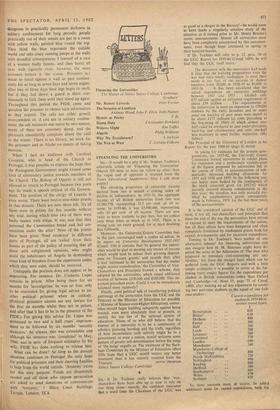SIR,-If Dr. Toulmin really believes that 'vice- chancellors have been
able up to now to rely on one thing alone—namely, the confident assurance that a word from the Chairman of the UGC was as good as a cheque in the Bursary'—he would seem to have made a singularly selective study of the situation as it existed prior to Mr. Henry Brooke's recent announcement. Almost all universities must have been comkletely unsurprised by this announce- ment, even though hope continued to spring in their battered breasts.
If Dr. Toulmin will refer to p. 12, para. 30 of the UGC Report for 1959-60 (Cmnd. 1489), he will find that the UGC itself states: The discussion with the universities had made it clear that the building programmes since the war had been totally inadequate to meet their needs in the face of the increase in student numbers from 50.000 in 1938-39 to 85,000 in 1955-56. . . . It has been calculated that the actual expenditure on university buildings between 1947 and 1957 . . totalled only £37 million against an estimated requirement of about £99 million. . . . The requirements of the univers:ties to meet an expansion to 170,000 students by the early Seventies and to make good the backlog of past years were stated to be about £175 millions (at costs prevailing at the beg nning of 1960) of which almost one- half could be attributed to past under-provision, back-log and obsolescence and over one-half was necessary to meet further expansion. (My italics.)
The Principal of the University of London in his Report for the year 1960-61 (page 6) stated:
In asking for estimates for the present quin- quennium, viz. 1957-62, the University Grants Committee invited universities to submit plans for expansion and a preliminary consideration of the figures proposed by universities led, in the course of 1956, to announcements of sub- stantially increased building allocations for 1957 and 1958 and 1959. In the following year our hopes were dashed by the inadequacy of the block recurrent grant for 1957-62 which scarcely covered existing commitments in the first year the situation was only partially rec- tified by supplementary grants subsequently made in February, 1959, for the last three years of the quinquennium.
. .
It is the considered opinion of the UGC and of most, if not all, vice-chancellors and principals that since the end of the war the universities have striven to expand to meet the requirements of the nation, but all their efforts have been hampered and often completely frustrated by inadequate grants both for capital developments and for recurrent expenditure.
Turning to Dr. Toulmin's 'bare outline of one alternative scheme' for financing universities one can imagine how H. M. Bateman might have de- picted the scene in the Athenteum of 'The man who pcoposed to introduce cost-accounting into uni- versities,' but from the meagre facts which can be gathered from the UGC Reports and with a little simple arithmetic it is possible to arrive at the fol- lowing (very crude) figures for the expenditure per student in British universities (other than Oxford and Cambridge—cf. Note 15, page 75 of Cmnd. 1489), after making an ad hoc adjustment by count- ing two part-time students as the equal of one full- time student : Current expenditure per
student in 1959-60 to nearest round figure • £ Birmingham
610
Bristol
610
Durham
490
Exeter
360
Hull
360
Leeds
500
Leicester
360
Liverpool
570
London
640
Manchester ..
540
Manchester College of Technology
800
North Staffordshire
520
Nottingham ..
490
Reading
800
Sheffield
580
Southampton • •
460
Wales
470
Scotland
420
To these amounts must, of course, be added additional sums for capital expenditure, both for current-replacement and for future expansion. This
• would probably augment these figures by at least 25 per cent.
The UGC Report for 1959-60 Table 11—Sum- mary of Income for the year 1959-60—shows that tuition and other fees paid by students (including Ministry of Education grants for teachers in train- ing) amounted to exactly 10 per cent, of the total income of the universities.
Very roughly indeed, therefore, one can arrive at the following average amount which each student.. would require, whether from public tunds or other- wise, in order to cover his costs for each year of his course: Fees to cover recurrent costs .. 600 Contribution to capital costs .. 150 Personal maintenance (twelve months) 450 Total .. 1,200
This figure is, of course, little more than a rough guess, but will be good enough for present purp6ses. Dr. Toulmin says: 'If they want 100,000 more students to go to universities, they will have to Pay 100,000 more "student grants."' Taking this above rough estimate, 'They' will have to pay £120,000,000 per annum.- When one remembers that 'They' will be the Education Committees of the Local Education Authorties in the great majority of cases; that the Local Education Authorities will be operating within the 'block grant' system, that on the basis of current figures for comparative expenditure per student any LEA would be almost certain to prefer to send two students to (say) Exeter, Hull or Leicester rather than to send one to Reading or Manchester College of Technology; Dr. Toulmin must not be surprised if his alternative scheme is received in university circles with a marked lack of enthusiasm. Angry though they may be, and with very good reason, universities will almost certainly prefer to cling on to nurse UGC for fear of something very much worse.



































 Previous page
Previous page